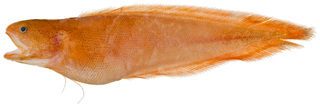
The cusk-eel family, Ophidiidae, is a group of marine boney fishes in the order Ophidiiformes. The scientific name is from the Greek ophis meaning "snake", and refers to their eel-like appearance. True eels, however, diverged from other ray-finned fish during the Jurassic, while cusk-eels are part of the Percomorpha clade, along with tuna, perch, seahorses, and others. Unlike true eels of the order Anguilliformes, cusk-eels have ventral fins that are developed into a forked barbel-like organ below the mouth. In the true eels by contrast, the ventral fins are never well-developed and usually missing entirely.

The viviparous brotulas form a family, the Bythitidae, of ophidiiform fishes. They are known as viviparous brotulas as they generally bear live young, although there are indications that some species do not. They are generally infrequently seen, somewhat tadpole-like in overall shape and mostly about 5–10 cm (2–4 in) in length, but some species grow far larger and may surpass 60 cm (2 ft).
The Fiordland brotula, Fiordichthys slartibartfasti, is a rare viviparous brotula found only in the Fiordland region of the South Island of New Zealand. It is inhabits spaces in rock rubble and is found at depths of from 10 to 12 metres. This species grows to a length of 11.1 centimetres (4.4 in) SL.
Fiordichthys is a genus of viviparous brotula native to the southwest Pacific Ocean.

The Mexican blind brotula is a species of viviparous brotula endemic to Mexico, where it is found in sinkholes and caves. It is known as sak kay in Mayan and dama blanca ciega in Spanish. This cavefish grows to a standard length of 9.7 cm (3.8 in). It is the only known member of its genus.

Saccogaster is a genus of viviparous brotulas. They are found in the western Atlantic and Indo-Pacific.

Bidenichthys is a genus of viviparous brotulas.
The Red brotula is a species of viviparous brotula found along the North American Pacific coast from Alaska to Baja California. This fish is often displayed in public aquariums. This species grows to a length of 46 centimetres (18 in) TL. The red brotula is the only known member of its genus.
The Taiwan coral-brotula is a species of viviparous brotula, the only known member of its genus, found mostly in the surge zone of the waters around Taiwan and the Philippines where it lives amongst rocks. This species grows to a length of 6 centimetres (2.4 in) SL.
Calamopteryx is a genus of viviparous brotulas.
Cataetyx is a genus of viviparous brotulas.
Dermatopsoides is a genus of viviparous brotulas.
Grammonus is a genus of viviparous brotula.

Hephthocara is a small genus of Indo-Pacific viviparous brotula.
Paradiancistrus is a genus of viviparous brotulas.

Brotula is a genus of cusk-eels. It is the only genus is the subfamily Brotulinae.

Petrotyx is a genus of reef-dwelling cusk-eels.
Bidenichthys beeblebroxi is a species of common reef fish of the family Bythitidae, and one of three species in the genus Bidenichthys. The species is found in the coastal waters off North Island and northern South Island, New Zealand. It is a common, uniformly gray-brown fish, ranging from SL 6.5–9.5 centimetres long in one study, found in holes beneath rocks and boulders in kelp forest and other reef habitats from the surface down to depths of 30 metres (98 ft). The species was described by Paulin in 1995.

Brotula barbata, commonly known as the bearded brotula, Atlantic bearded brotula, or sugarfish, is a species of cusk-eel in the genus Brotula. It lives in the Atlantic Ocean, in depths of up to 300 meters. Its coloring ranges from olive-brown to red-brown, and it grows up to be around 50 centimeters. It has a carnivorous diet, and it is oviparous.

Bythitinae is a subfamily of viviparous brotulas, one of the two subfamilies in the family Bythitidae. This subfamily is characterised by having the dorsal, caudal and anal fins combined. They are mostly found in temperate to tropical seas, from reefs to the benthopelagic zone, but some species from the North Atlantic Ocean occur in into Arctic waters.






